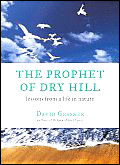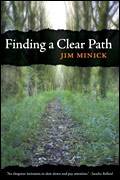“It was on Cape Cod during fall a few years back, after the century fell but before the towers did, that I began paying a series of visits to the writer John Hay.” With this opening line in The Prophet of Dry Hill, David Gessner sets the tone for a quest that is both personal and transcendent. Like “Call me Ishmael,” this sentence also lets us know that we are in the hands of a writer with a strong grip on the helm. It’s safe to lean back and relax into the journey.

Someone to look up to.
Photo: iStockphoto.
The book chronicles Gessner’s relationship with nature writer and activist John Hay, which began when Gessner approached Hay, then in his 80s, to interview him for a biography. As they talk and walk throughout the changing seasons on Cape Cod, Gessner is pulled into Hay’s ongoing dialogue with his place and its nonhuman inhabitants. What does it mean to know a place? Can human beings learn to get past our limited consciousness to coexist with other species? Is there any hope for our plundered, poisoned planet? And, yes, what is salvation?
Such questions are de rigeur for the genre of “nature writing,” a canon of rant and rapture spawned by Henry David Thoreau and continued by his literary descendants — from John Burroughs and John Muir to Terry Tempest Williams and Barry Lopez. This bunch can get a tad churchy, a quality Gessner skewered in his 2004 memoir, Sick of Nature: “Throw an imaginary kegger and fill the room with nature writers throughout history and you’ll get the idea. Henry Beston, looking dapper if overdressed, alternates tentative taco dabs at the cheese dip with Aldo Leopold; Barry Lopez sits in the corner whispering to Thoreau about the sacredness of beaver dams; Joseph Wood Krutch stands by the punch bowl and tells Rachel Carson the story of how he first came to the desert as Carson listens earnestly. In fact everything is done earnestly; the air reeks with earnestness.”

The Prophet of Dry Hill:
Lessons from a Life in Nature
by David Gessner,
Beacon Press,
188 pgs., 2005.
Given this ambivalence about the genre, Gessner manages to avoid a stifling reverence for his primary subject through a command of craft: by keeping the story personal and specific, couched within his unfolding relationship with Hay, Gessner is able to raise grand questions without grandiosity.
Yet achingly earnest questions churn at the core of Hay’s thinking and writing, and they form the subtext of the narrative. When Hay, an essayist who has penned 15 books, watches terns squawking offshore, he sees transcendence, ritual, harmony, balance, communion. He just can’t help it. And he mourns humankind’s insistence on setting itself apart from other sentient beings at a cost to all forms of life. In “Rescue Mission,” an essay about a botched attempt to save oil-soaked seabirds, Hay observes: “If the only environment we pay attention to is the one we alter to suit our convenience, then we lose our inherited sense of a multitude of environments … Will we become so detached from our sources in the company of existence as to be unable to rescue ourselves?”
The willingness to grant other beings their own consciousness and to count humans as part of a larger natural scheme are, in Gessner’s view, what made Hay’s writing “original and inspired.” Hay’s book The Run, about the annual herring migration, predated Silent Spring and infused life into a genre that sometimes lapsed into mere description, as though humans were reporting from a separate plane of existence. “John’s approach was something different altogether,” Gessner writes, “a message from inside.” If Gessner lapses into the dreaded earnestness in such passages, the tone is at least true to his subject and its subtext.
Although midway through Prophet Gessner drops the biography idea, realizing that he has “begun to regard John less as a subject, more as a friend,” he lets Hay do a lot of the talking and lays down enough biographical detail to make sense of Hay’s diatribes. The story’s climax comes when both men confront the fact that they may be leaving Cape Cod, putting down their shared struggle to stop rampant development. The defeated Hay, who once penned in his journal, “Hold on, hold on, help is not coming,” tells Gessner, “This is a dying place.” But Gessner, younger by nearly 50 years, can’t give up the quest for salvation, for hope, and he now seeks it by following Hay’s creed of shedding the human self, the better to commune with whatever lies outside.
Churchy? Well, yes. But straight talk, honest grappling, and the feel of sand underfoot save Gessner from the piety of some of his peers.

Finding a Clear Path
by Jim Minick,
West Virginia University,
277 pgs., 2005.
The Virginia Real
A walk with John Hay would probably send Jim Minick wading into the waves with rocks in his pockets. Minick, a farmer and writer who lives in southwest Virginia, publishes a regular column in The Roanoke Times. His book, Finding a Clear Path, compiles previously published essays and other writing.
The pieces are of different types. Some, like the title essay, chronicle observations from walks through the Virginia countryside. Others, like “Homes for the Holidays,” are straightforwardly didactic. Still others, such as “Green Lumber, Green Profits: Sustainable Forestry in Appalachia,” are reported articles. Sometimes the juxtapositions of transcendent observation and how-to are jarring. The writing is also uneven: at times it soars, but some passages flap awfully hard to leave the ground.
Of more significance, Minick’s relentless cheer sometimes undercuts the import of his observations. In “Counting Birds at Christmas,” for instance, he describes two men, Bill and Blair, who have long taken part in the Audubon Christmas Bird Count. The men observe that many species of birds have dwindled steadily as development has claimed their habitat. “Still,” Minick writes, “Bill and Blair regularly find much to hearten them.” I would have preferred Minick to follow their observation to its obvious conclusion, and to comment more substantively on the issues, even if within the essay form: What kinds of habitat? Where? What would reverse the trend?
Minick’s joyous appreciation of his part of the world will give pleasure to many fans of conventional nature writing. But the disheartening reality glimpsed by Gessner and Hay would add ballast to his celebration of berries and birdsong.


